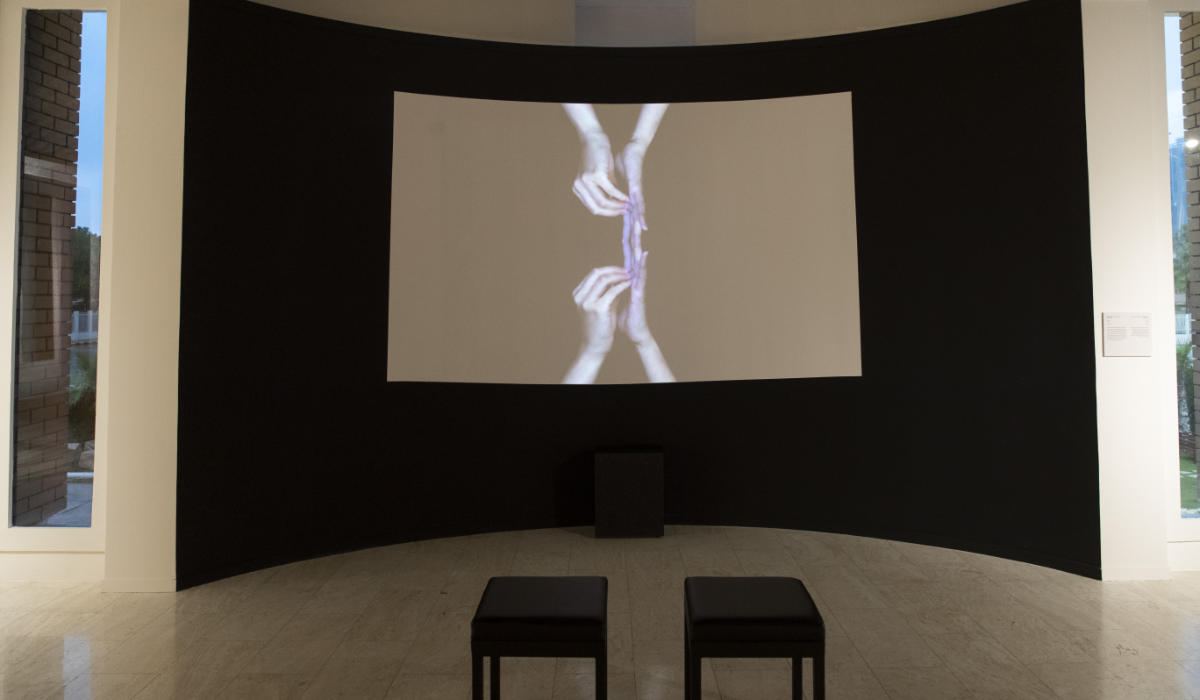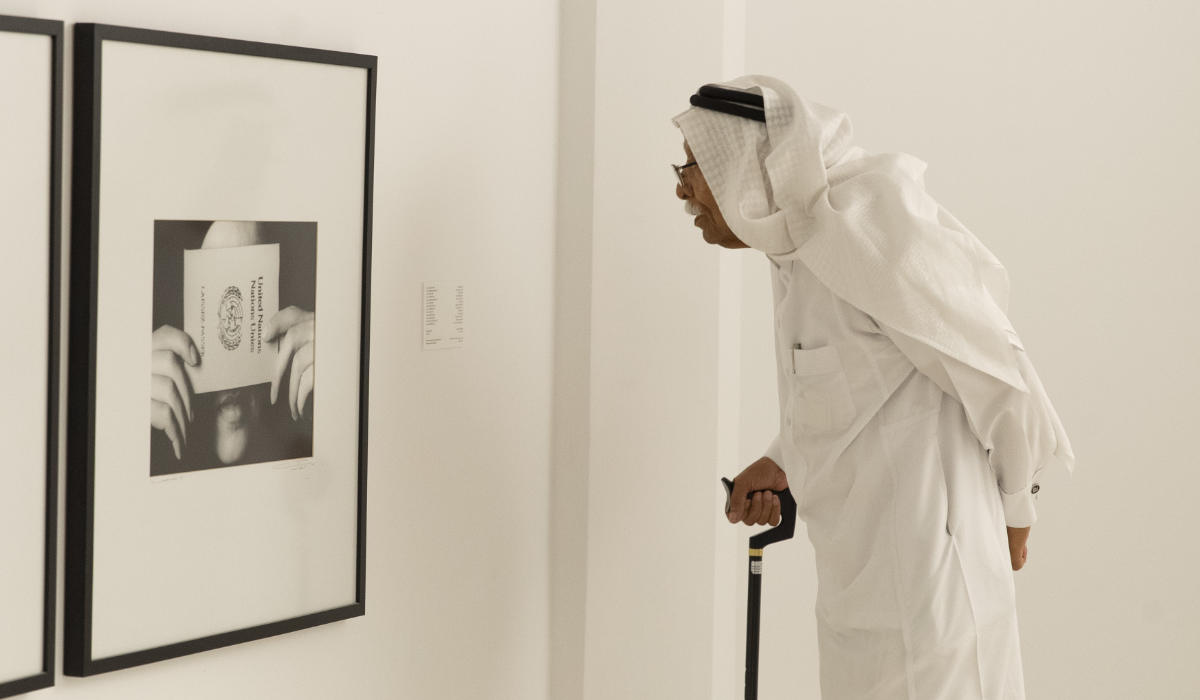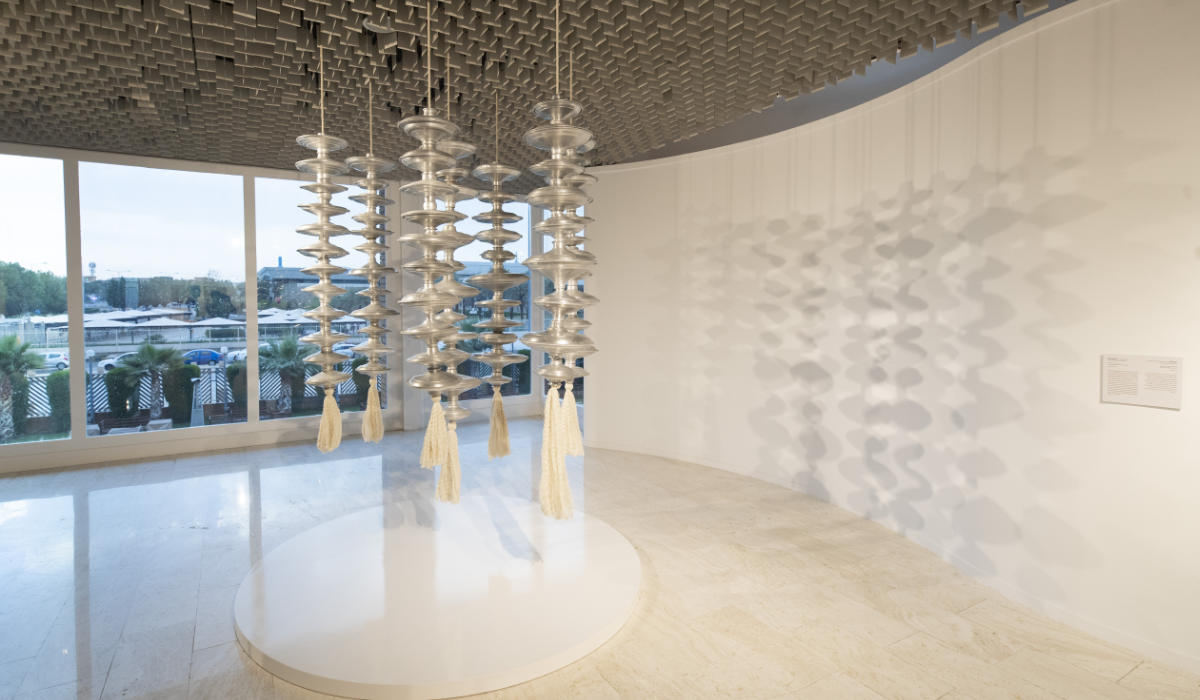RIYADH: Misk Art Institute’s spring display, titled “Brand New Ancients,” presents 17 artists’ existing works derived from oral and material traditions, showing how history can revive itself in innovative ways.
Curated by Wassan Al-Khudhairi and Cecilia Ruggeri, the exhibition was born out of Kae Tempest’s poem of the same title, both telling a story of the past’s impact on future potential.
Al-Khudhairi told Arab News: “Tradition is such a loaded word, and it has so much meaning to so many people in a lot of really strong ways.

Saudi artist Dana Awartani presents "Love is my Law, Love is my Faith," embroidering on silk as a response to poems by Abdalisian scholar Ibn Arabi that describes an intimate experience with the Kaaba. (Photo/Misk Art)
“In our contemporary culture today, not just artists, but a lot of people, look at stories, ideas, techniques, traditions that come from the past as ways to tackle our current culture, and even to envision the future.”
Paralleling the theme, the exhibition has been staged using only existing works.
“You can take the work that’s been made two, five, eight years ago, and put it in another context and breathe a different life into it and allow it to have another life through its relationship to the theme and the other works around it,” Al-Khudhairi said.

Taking Lapis Lazuli stones found in Afghanistan, Kuwaiti-born Hamra Abbas creates an unconventional mosaic out of the second highest mountain in the world, K2, titled 'MOUNTAIN 1.' (Photo/Misk Art)
Kuwait-born visual artist Hamra Abbas has used lapis lazuli stones from Afghanistan to create a mosaic of K2, the second-highest mountain in the world, and titled it “Mountain 1.”
The structure is described as a relic of Pakistani history, embodying perfection, paradise, and truth. The artist used the classical 17th-century Florian marquetry technique of pietra dura, which later became prominent in her local region and used in the Indo-Islamic Mughal architecture style.
In our contemporary culture today, not just artists, but a lot of people, look at stories, ideas, techniques, traditions that come from the past as ways to tackle our current culture, and even to envision the future.
Wassan Al-Khudhairi Curator
Blocks of stone were painstakingly cut into fragments and then individually polished, shaped, and pieced together to form the 320-kilogram artwork as a symbol for cultural exchange and diversity, gluing together notions and materials from around the world.

Sarah Brahim’s video installation “Bodyland” depicts the inheritance and generational passing-down of grief through genetics. (Photo/Misk Art)
Abbas told Arab News: “It was a completely experimental piece. I did not know I could create an image using only lapis. You can’t tell what you’re making for months while you’re making it. It’s only after you polish it that you see the result.”
Pakistani artist Wardha Shabbir’s miniature painting, “In Search of Light,” uses the atmosphere of the city of Lahore, nuanced by bright yellow and orange colors, to portray symbols of loss, despair, hope, and survival inspired by her experience as a woman from Pakistan.
It is an emblem of personal traditions as well as ones handed down through generations, commemorated by the drawings of flora native to the region and mapped across archival paper.

Under the theme “Brand New Ancients,” 17 artists share their existing works derived from passed down oral and material traditions across various cultures, considering how history has a tendency to revive itself in innovative ways. (Photo/Misk Art)
Shabbir said: “I’ve been looking at the city and how it evolved and grew, and all those plants became my foremost influence. My mother was a gardener and when we were younger, we took care of plants more than our toys, so I developed a relationship with them.”
Her drawings depict the experiences, people, economic and political turmoil, and struggles for survival within Lahore.
“This is how I’m taking the (miniature painting) tradition forward. This is how I stand in the world,” she added.

Using the principle that a poem is not a poem unless it has seven lines, Saudi artist Maha Malluh presents “Riyadh Poem,” the final piece within her Food for Thought series. The artwork is a seven-piece hanging installation made of 156 aluminum pot covers. (Photo/Misk Art)
Using the principle that a poem is not a poem unless it has seven lines, Saudi artist Maha Malluh’s presentation, “Riyadh Poem,” is the final piece in her “Food for Thought” series.
The artwork is a seven-piece hanging installation made of 156 aluminium pot covers, reflecting traditional motifs within Islamic culture, such as the seven rounds in Hajj around the Kaaba, the seven heavens, and the seven days of the week.
Saudi contemporary artist Ahmed Mater’s “Ashab Al-Lal: Fault Mirage, A Thousand Lost Years” exhibit layers glass slide images of the past and present, allowing them to instantly interact.
Riyadh-born visual and performance artist Sarah Brahim’s video installation “Bodyland” depicts the inheritance and generational passing-down of grief through genetics.
Co-curator Ruggeri, also a Curator at Misk Art Institute, told Arab News: “It was an incredible journey to work on this exhibition alongside Wassan and the institute. The exhibition shows that traditional practices and modes of thinking and creation are not in opposition to innovation.
“I hope that visitors will gain an understanding of how tradition informs so much of contemporary art practice, and how it paves the way for artists to discover new ways of thinking and doing.”
The institute’s show not only exhibits the recycled crafts of ancient traditions, but also incorporates contemporary understandings of heritage, contextualized in modernity. By digging into the past, “Brand New Ancients” aims to carve a path for the future.
The artists’ works will remain on display at the Prince Faisal bin Fahd Fine Arts Hall in Riyadh until July 15.
Also among the featured artists are Filipino Pacita Abad, Palestinian Dana Awartani, Mexican Abraham Cruzvillegas, American Derek Fordjour, Kuwaiti Tarek Al-Ghoussein, Joana Hadjithomas and Khalil Joreige from Lebanon, Canada-based Lotus Laurie Kang, Qatari American Sophia Al-Maria, Nasser Al-Salem from Saudi Arabia, and Italian duo Ornaghi and Prestinari.


































